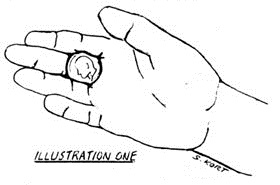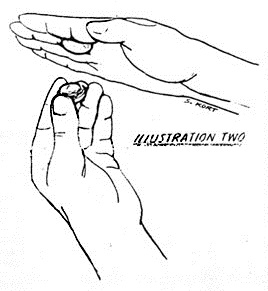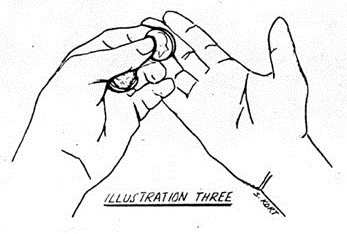

Home → Inside Info → RB Freebies →
Silver Replacement
Silver Replacement
Copyright � 1980 by Ron Bauer
EFFECT: Two small, peculiar objects are shown. One is a translucent plastic replica of an American half dollar. The other is a small lump of silver-like metal. The two objects are placed together and held at the fingertips of the palm-up left hand. The right hand waves over them and, suddenly, the two objects are transformed into a half dollar which may be examined since it is a half dollar and nothing more. The hands, however, cannot be examined; but the impression on the audience is that they are innocently empty, if not clean.
This is Dr. Boris Zola's Silver Extraction in reverse. Motivation for coming up with this effect was that I have always liked the elements of the Boris Zola mystery, however, there's a bluntness to the climax. Very few people can recognize immediately that the small piece of plastic is a replica of a half dollar. In this version, however, they get a good look at the replica and the lump before things get magical. Understanding is essential to appreciation.  By the way, the most interesting lump I've seen... as far as this trick goes, anyway... is the one supplied with the Johnson Product's version of the Silver Extraction. This lump has a portion of the tail side of a half dollar embossed on it. Coat the back of the lump with some magician's wax, and proceed.
By the way, the most interesting lump I've seen... as far as this trick goes, anyway... is the one supplied with the Johnson Product's version of the Silver Extraction. This lump has a portion of the tail side of a half dollar embossed on it. Coat the back of the lump with some magician's wax, and proceed.
You begin by hiding a real half dollar in your right hand. It's clipped at the base of the fingers between the index and ring finger, and is flat against the middle finger. (See illustration 1). The coin should be tails side toward the fingers.
Without letting anyone spot the coin hidden in the right hand, pass out the plastic half dollar replica, and be sure everyone gets a good look at it. Next bring out the lump and give everyone a look at it. Using both hands, position the plastic coin at the fingertips of the palm-up left hand. Grip it with the thumb and the middle finger. Keep all the fingers of the left hand close together. The plastic piece should be tails side up.
 Pick up the lump with the right hand and place it on the plastic coin, the embossed surface of the lump showing. Now, as though you're positioning the lump so it won't fall, press the two firmly together so the wax will make them "one." Make sure you keep the plastic coin level so no one gets the idea that these two pieces are anything but separate. For instance, if you were to turn them at an angle, the lump would not fall off because of the wax, and everyone would then know that the two pieces were stuck together. Part of the mystery of this effect is how you could possibly manipulate the loose pieces without making any noise.
Pick up the lump with the right hand and place it on the plastic coin, the embossed surface of the lump showing. Now, as though you're positioning the lump so it won't fall, press the two firmly together so the wax will make them "one." Make sure you keep the plastic coin level so no one gets the idea that these two pieces are anything but separate. For instance, if you were to turn them at an angle, the lump would not fall off because of the wax, and everyone would then know that the two pieces were stuck together. Part of the mystery of this effect is how you could possibly manipulate the loose pieces without making any noise.
Next, open the right hand palm down and come across the top of the two pieces held in the left fingers, covering but not touching them. (Illustration 2). Wave the right hand back and forth a couple of times. Move the right hand aside to give the audience one last look at the pieces, then cover them again with a waving action. During this action, in a split second, the left fingers release the two pieces so that they fall into the finger-palm position, at the same time the right fingers relax just slightly so that the palmed half dollar replaces the pieces in the exact same position. Wave one or two more times, and slowly remove your right hand showing the transformation. Stop all movement and let the change sink in for a few seconds.
 Turn the right hand palm-up and move the left hand to place the half dollar on it. Do it this way: Press the left thumb forward toward the fingers so that it slips off under the edge of the real half dollar. The thumb goes underneath it and grips the coin against the forefinger and middle finger. (Illustration 3). Then turn the left hand palm-down move over to the right hand, and drop the coin onto it. Don't move the left hand until the right hand is moving.
Turn the right hand palm-up and move the left hand to place the half dollar on it. Do it this way: Press the left thumb forward toward the fingers so that it slips off under the edge of the real half dollar. The thumb goes underneath it and grips the coin against the forefinger and middle finger. (Illustration 3). Then turn the left hand palm-down move over to the right hand, and drop the coin onto it. Don't move the left hand until the right hand is moving.
There are a couple of additional points. First, if this is handled as explained, there is a clear impression on the spectators that they see clearly into both of your hands all the time. Secondly, any difficulty in depositing the real coin into position on your left fingertips from the right hand position can be overcome. The key is to press, at the critical moment, with the right middle finger. Don't try to release the coin with the right and grab it with the left or you'll spoil the transformation. If you do it correctly, it will instantly go into the exact position vacated by the lump and plastic replica. And, if the left hand never moves during the transformation, the illusion is quite good. Of course, you'll discover that for yourself when you perform it.
Copyright � 1980 by Ron Bauer